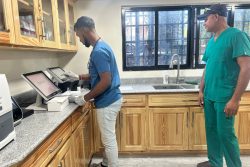For as far back as local chocolate lovers can remember, the name Cadbury has always been associated with the product. Truth be told it is as much the elaborate wrapping – the inner layer of shiny silver covering the product itself and after that the sleeve emblazoned with the makers’ name – that has attracted local consumers. For generations, the brand has always been thought of among locals as being the ultimate in confectionery.
Nothing, moreover, is likely to supplant the Cadbury brand for some time yet, though the fact that, finally, a local manufacturer is on the cusp of challenging for a share of the market provides testimony to the extent of the road that our ambition has traveled.
Louis Holder is not new to the manufacturing sector. His coffee has long caught the attention of local consumers, not least in some urban cafeterias and not a few kitchens. He is not, however, a man to rest on his laurels and the emergence of a local brand of Chocolate almost certainly marks the start of an energetic excursion in marketing that is unlikely to stop until the product makes a meaningful impact.

Holder, the Chief Executive Officer of Amy’s Pomeroon Foods, says that he expects his bean-to-bar chocolates to make a public appearance in March. He is awaiting the arrival in Guyana of two key pieces of equipment, due next weekend. Three of the five pieces of equipment that will be pressed into service in the production of the chocolate are already in place. These are a roaster, a winnowing machine and a colloidal mill. These have long been in use in his coffee production enterprise and will now ‘double up’ in his chocolate production venture.
Back in October 2015 Holder launched Amy’s Pomeroom Foods which continues to produce coffee for the local market. He concedes, however, that aggressive marketing has not made a significant dent in coffee sales. Last year, a 5% increase in market share earned the company a mere G$1 million. While the coffee is stocked by supermarkets and stores across the country Holder has come to terms with the reality that it is not uncommon for new companies to take at least five years before they begin to realize meaningful returns. So that while he sees his decision to introduce chocolate to the market as means of adding another string to his entrepreneurial bow he understands that it may not necessarily be an instant success on a market in which he is challenging the ‘heavy hitters.’
If Holder is concerned about the profitability of his products he is equally mindful of meeting quality and food safety standards. His first concern, he says, is with producing high – quality and healthy products using local raw materials and that has remains his top priority. He is, for example, concerned with the stipulation of the United States Food and Drugs Administration with regard to the food value of cocoa. The USFDA considers a product chocolate if it contains at least 10% cocoa, the product containing antioxidant properties that are beneficial to the human body.
Amy’s Pomeroon Foods’ chocolate will comprise seventy five percent cocoa, and twenty five percent honey, a concession he says to the widespread health concerns associated with sugar.
He values his decision to source all of the raw materials for his new product locally, particularly from sources along the banks of Pomeroon River as well as from the Blue Flame Women’s Group in Region One. He is, he says, confident that the farmers in that region will respond enthusiastically to the realization that they are being offered a reliable market for their cocoa beans. Holder says he has already engaged the NAREI regarding increasing local supply of cocoa beans and it has responded by restoring some farms in Hosororo and the re-opening of an existing processing/drying plant there. Amy’s Pomeroon Foods has an existing processing plant in the Pomeroon River will also be pressed into service.
Plans for the acquisition of raw materials also include sourcing at least some of the honey required for chocolate production from Bee Keepers in the Pomeroon River. His Organization has already engaged some producers in that regard.
The process of manufacturing chocolate begins with harvesting the pods and removing the white pulp containing the cocoa beans through fermentation. This is then taken to the factory in Liliendaal for roasting following which a winnowing or de-shelling process will take place. The inside of the winnowing machine has serrated like edges which will open the beans after which the fans inside the machine will disperse the husk, leaving behind the nibs. (broken beans). These are then placed in a Colloidal Mill for grinding and liquefying into a thick paste. After that the thick ‘syrup’ will be poured into a Malangeur machine that will grind the paste to a texture of below twenty microns, at which point it would have realized a smooth, silky texture. Tempering comes next. This is a process of raising and lowering the temperature of the chocolate mix in order to realize the desired level of crystalzation.
Along with the cracking sound emitted when the chocolate is broken, tempering the chocolate also produces a glossy sheen. At this stage, all other ingredients, including honey, are added and this will then be squirted into molds which are placed in a temperature-controlled room to form.
Tyrone Gravesande, the company’s Operations Manager told Stabroek Business that the company has already received encouraging feedback from its tasting events though they are only too well aware that different challenges could materialize once the product is placed on the open market. Holder, however, is sufficiently encouraged to plan to introduce a chocolate-based breakfast spread on the market by the end of 2019.
Having increased the level of sophistication over time, Holder’s operations are run by two factory workers rather than the five that he began with. Holder however stressed that the economic benefit from his operations is in the farm belts where raw materials are acquired. These farmers increase their incomes as a result.
At the outset, he anticipates that the operation will require approximately two tonnes of cocoa annually and is already working with farmers in an effort to raise production levels. Similar engagements will have to be undertaken with local beekeepers in order to secure adequate honey supplies. Packaging for the product is being manufactured by Flexotech Inc of Diamond, East Bank Demerara. The advent of a local packaging company, he says, is a significant step in the right direction since in the past sourcing packaging materials from China had its challenges.
Perhaps not surprisingly, the reliability of electricity supply is his primary concern. Power shutdowns can ruin entire batches of product so that Holder is in the process of contemplating a solar option. After that, he is preparing to face the challenge of ISO certification, a prerequisite for exploring export market possibilities though the immediate challenge will be the pioneering launch of another breakthrough locally manufactured product on the Guyana market.










